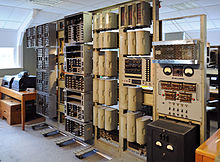Harwell computer
The Harwell Computer , also known as the Harwell Dekatron Computer , later called the Wolverhampton Instrument for Teaching Computing from Harwell ( WITCH ), is a British mainframe computer commissioned in 1951 . After three years of restoration, it has been operational again since 2012, making it the oldest functioning electronic computer in the world. The computer uses relays for the arithmetic unit and counters .
history
Atomic energy research
The two and a half ton mainframe computer was built from 1949 for the “ Atomic Energy Research Establishment ” in Harwell , Oxfordshire . The three developers in Harwell's electronics department included Edward (Ted) Cooke-Yarborough and Robert (Dick) Barnes, who also witnessed the reconstruction of the computer. It went into operation for the first time in 1951. It was retired as obsolete as early as 1957.
Teaching aids
After a university competition, the computer came to the "Wolverhampton and Staffordshire Technical College" (which later became the University of Wolverhampton ), where it was used until 1973 as a teaching aid in computer science . Here the machine got the name “ WITCH ” (German: “Hexe”) for “Wolverhampton Instrument for Teaching Computing from Harwell”.
Science and Industry Museum
Retired for the second time as obsolete, WITCH came to the “Museum of Science and Industry” in Birmingham in 1973 . When this museum closed in 1997, WITCH was dismantled and stored until further notice.
National Museum of Computing
Kevin Murell of the National Museum of Computing in Bletchley Park accidentally discovered parts of the computer in a photo in 2009. Under the direction of Delwyn Holroyd, the individual parts were restored and reassembled. On November 20, 2012, WITCH was put back into operation in front of an interested audience - including some of the designers and members of the original operating personnel.
Technical details
The Harwell Computer was designed and built by the Electronics Division of the Atomic Energy Research Establishment. Its main memory initially consisted of 20, later 40 eight-digit Dekatron registers, hence the name “Harwell Dekatron Computer” that is sometimes used. Numbers were not stored in binary, but in decimal. The input took place via punched tape , the output via a teleprinter or also on punched tape.
The Harwell computer was not particularly fast because the arithmetic unit worked with relays , i.e. electromechanically . It took him up to ten seconds to multiply two numbers. In tests, some people even managed to keep up with the computer multiplying for a while. But he was very reliable and could work for days without any problems. It was replaced by a transistor- based computer , the Harwell CADET .
It could occasionally be used as a stored program computer in the sense of the Von Neumann architecture , but that was not his usual way of working.
literature
- BV Bowden (Ed.): Faster than thought. A Symposium on digital computing machines . Pitman, London 1953, therein EH Cooke-Yarborough: The Harwell Electronic Digital Computer , Chapter 9, pp. 140-143, archive.org
Web links
- Danny Kringiel: Historical digital computer is running again . one day , November 27, 2012
- The Harwell Computer, also known as the 'WITCH' Computer. Collection of texts and images on the website of the Computer Conservation Society (English)
Individual evidence
- ^ A b John D. Sutter: 61-year-old computer springs back to life . CNN.com, November 21, 2012 (English).
- ↑ DGA Thomas was also involved. Barnes, Cooke-Yarborought and Thomas published it in Electronic Engineering August / September 1951.
- ^ Nicole Kobie: Harwell Dekatron: rebooting the most dependable computer ever . PC Pro.
- ↑ a b c d e f Mark Ward: Two-ton Witch computer gets a reboot . BBC News Technology, November 20, 2012 (English).
- ^ A b Jack Howlett: Computing at Harwell . chilton-computing.org.uk, 1979 (English).
- ↑ Relay .
- ↑ Harwell Dekatron . PC Pro; mentions a test by Bart Fossey who was able to follow the computer for half an hour.

